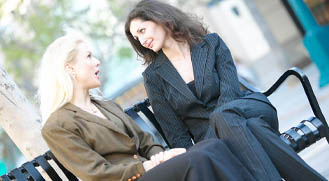My graphic picture of friendship has always been two contiguous circles each of which has a smaller circle inside. The outer circle symbolizes the man, and the inner circle the boy inside the man. Psychologists and our wives have always known that inside of each man is still a little boy. Many times he runs the show ----particularly in the emotional roles of close friendship.
This totally unscientific approach to analyzing friendship has led me to believe that real friendship happens after two men get pleasantly acquainted (the outer circles). The real friendship begins when the two boys (the inner circles) accept each other. It is an interesting process to watch; though it is seldom completed. Often started, but seldom completed. For example, two men meet — get acquainted and begin to like each other. They keep this at a distance. Each suspects that if they could get closer they would like each other even more, so they start the process of introducing the two boys. For most men, this means working, playing or traveling together. Slowly the fence protecting the boy from the man is taken down.
If it seems that the two boys like each other, the fence continues to come down. However, if a point occurs when the boys don't jibe, the fence rebuilding begins.
Each of us wears a mask of protection in a particular area. We are usually not satisfied with that area. Therefore, we are careful about taking down the mask and opening that area to scrutiny by others. We are afraid for them to see it or even know about it. We wonder about their reaction. This mask is like a bandage. The larger the mask, the more wounded is the area that it protects and the more complicated and painful is the removal.
In the early stages of what is to be a genuine experience in friendship comes the almost sacred moment when the area covered by the mask is shown or better understood. It is slightly lifted or slightly shifted revealing the area of woundedness. This first moment has a poignant intimacy about it. The other person's reaction is carefully read by the mask wearer. With encouragement and understanding, the willingness to lift the mask grows.
It's wrong to think that the mask isn't part of the "real you." It is not only real, but it's usually very much needed. Masks are real just like bandages are real. Getting rid of them too quickly can be disastrous for the person and the growing relationships. Unfortunately, I've seen well-meaning people try to rip off someone else's mask without the sensitivity to realize that the skin underneath was attached --- and now bleeding.
Masks — even the best of them — have their downside. They create loneliness. They isolate the areas of discontent within our own life and being. They identify the parts we don't want exposed constantly. Real friendship shares this loneliness.
Friendship not only says that it understands --- it truly does. It's behavior understands. It's mindset and way of thinking understand. Friendship somehow feels the person is greater for bearing the handicap. Therefore, the handicap becomes a plus, not a minus, to the friend. You almost hear the little boy say to the other, "Hey, that's cool! Let's go play."


